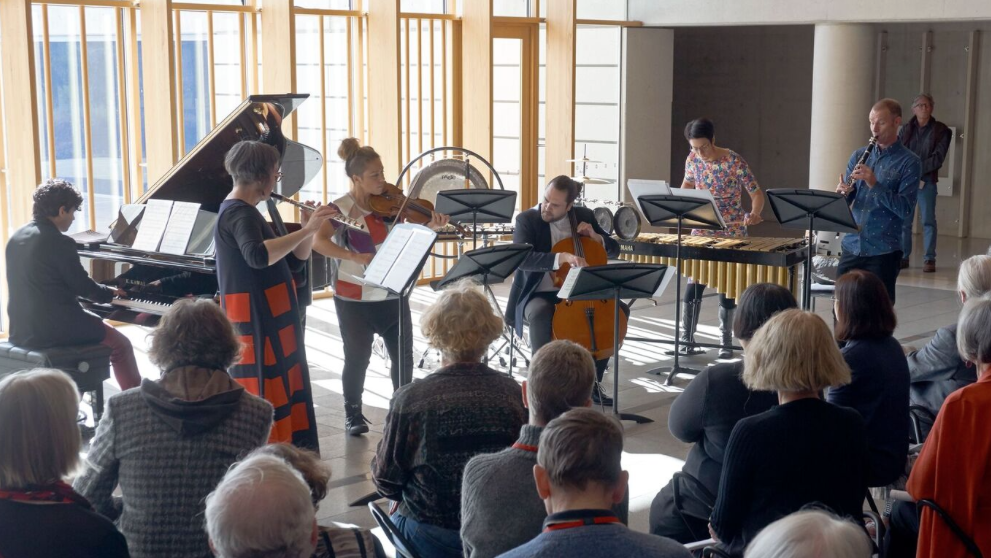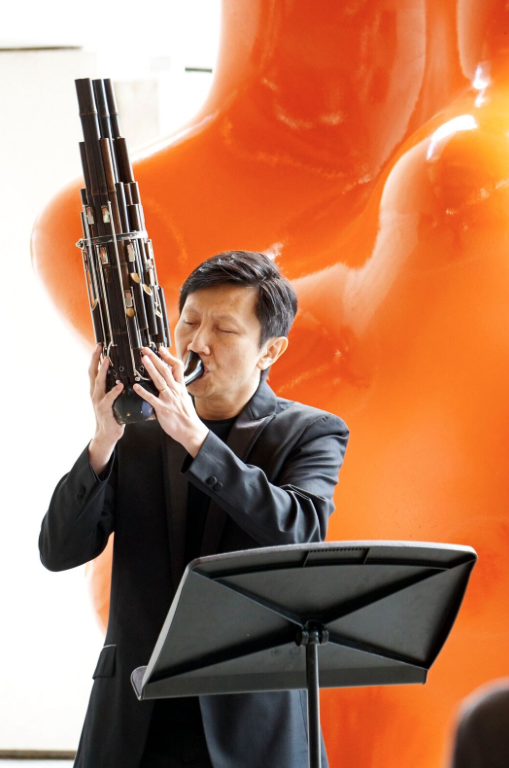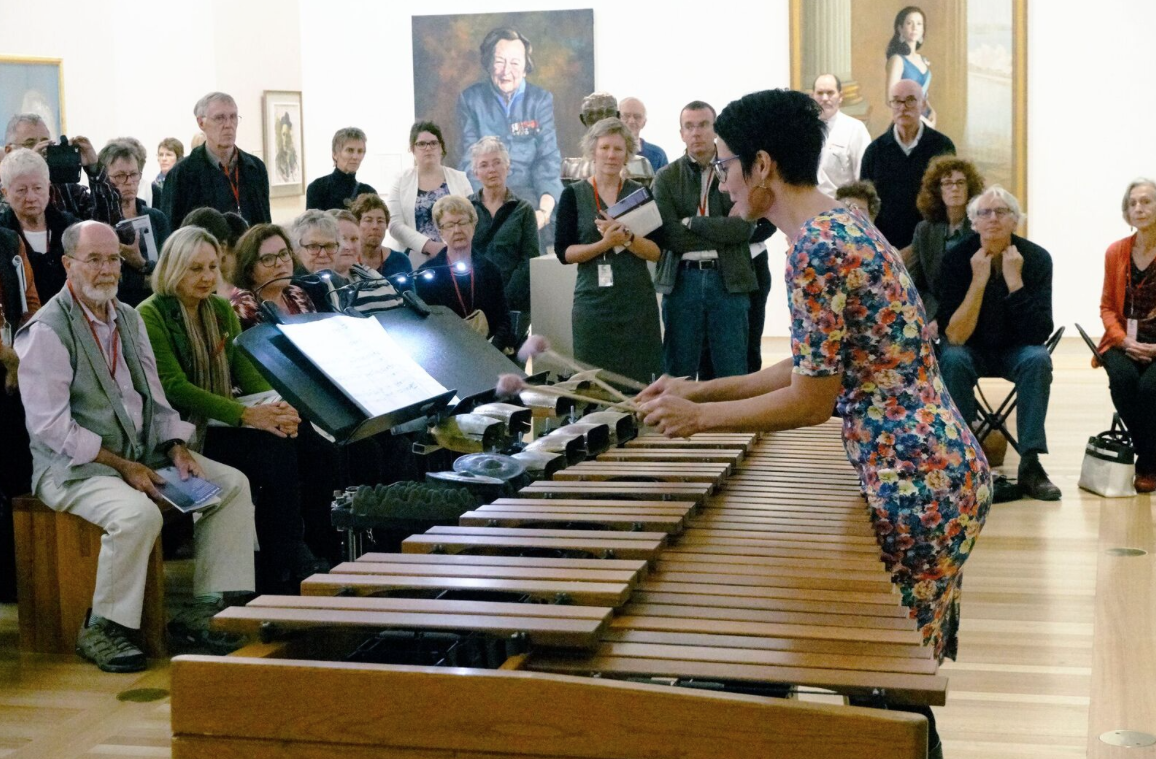Of all the distinctive public buildings in Canberra, the National Portrait Gallery would have to be my favourite. Opened in December 2008, about 18 months after my arrival in Canberra to live and work, the NPG – acronyms are mandatory in the ACT – sits modestly alongside its two imposing older sisters, the High Court building and the National Gallery, all gracing the banks of Lake Burley Griffin. The NPG is airy, uncluttered and unencumbered by its architectural significance. It opens out to embrace the full glory of Canberra’s autumn foliage. At this time of year, the city itself is a gallery, best viewed from the hills overlooking our bush capital.
The NPG has long been an enthusiastic and generous host for musical events and I have been to many memorable concerts in its spacious foyer. On one afternoon this week the NPG embraced an event that was an intriguing and important part of the programme of this year’s Canberra International Music Festival, aka CIMF.
Half the Sky: the Sound of the Sexual Revolution was not so much a series of mini-concerts as a reflection on the role of women in Australian music, composition and performance and reception. It’s hardly a novel theme – composer Natalie Williams will be channelling similar thoughts in Women in the Creative Arts (10-12 August, ANU) – but its reflections were presented in a deeply thoughtful and stimulating way.
Spread over almost an entire afternoon, Half the Sky comprised five events which were distributed in various NPG spaces, dodging paintings and photographs of notable Australian high achievers, many of them women. In the main, performances was given by a nucleus trio from that splendid Sydney group Ensemble Offspring (Jason Noble, clarinet; Zubin Kanga, piano; Claire Edwardes, percussion/leader/curator), with several supporting musicians including flautist Lamorna Nightingale, violinist Veronique Serret, and cellist Blair Harris.
 Ensemble Offspring performing at the National Portrait Gallery. Photos © Peter Hislop
Ensemble Offspring performing at the National Portrait Gallery. Photos © Peter Hislop
The first music heard was an aviary for the sextet, Avialae, by Cassie To, a very recent graduate from the Sydney Conservatorium – seven minutes of piccolo chirrups building to an impressive elegiac ending. Then a somewhat spectral piece for alto flute, cello and piano, Cendres (1998) by Kaija Saariaho, a Finnish composer based in Paris.
The audience, greater in numbers than anticipated, then migrated around various galleries, to experience short pieces by Felicity Wilcox, Amanda Cole, Cathy Milliken and Natacha Diels.
 Loo Sze-Wang at the Canberra International Music Festival
Loo Sze-Wang at the Canberra International Music Festival
Having successfully navigated the performance venues, whilst avoiding damage to art objects, the audience was faced with an unusual choice. Four pieces were presented in four locations at the one time. What to choose? Margaret Sutherland’s Little Trio (1960) for flute, clarinet and bassoon, was an affectionate (and solitary) tribute to one of the pioneers of Australian music. I had to sacrifice pieces by Katy Abbott and Sofia Gubaidulina to hear the premiere performance of an engaging piece by Joyce Tang, a composition teacher at Hong Kong University. This was the world premiere of a nine-minute solo Remembrance of the Old Stonewall Trees, deftly performed by her colleague from Hong Kong, Loo Sze-Wang, one of the world’s foremost expert performers on the sheng, the Chinese mouth-organ. Performed in the outdoor courtyard, the performance bristled in the brisk afternoon air, despite the whirr of an overhead helicopter and other more grounded traffic noises.
Back then into the relative warmth of the NPG’s theatre for a forum discussion moderated by Karen Vickery, the NPG’s Director of Learning and Visitor Experience. There were a few memorable moments in an otherwise oft-repeated thesis. Journalist (and occasional chorister) Laura Tingle noted how women, in the contemporary political climate in Canberra, are no longer exceptional, whereas in the arts (citing the conductor Simone Young) one seeks the exceptional. Otherwise, the session drew down on familiar themes of quotas and statistics. There was no mention of the composing techniques or terms of reference of women composers. Vive la difference? Perhaps for another time.
 Claire Edwardes at the Canberra International Music Festival
Claire Edwardes at the Canberra International Music Festival
Back into the foyer and this CIMF programme, largely curated by Claire Edwardes, saved what was – in my opinion – the best music for last. The Composer-in-Residence at this year’s CIMF is Professor Chen Yi, born in China in 1953 and an American resident since 1988. Her distinctive blend of traditional Chinese themes and sounds along with the vocabulary of contemporary post-Modernism has cheered the soul of several CIMF programmes, enhanced by her own generous presence, at once smiling and searching. Qi (1997) is a quartet for flute, cello, percussion and piano whose title signifies “the circulating life force whose existence and properties are the basis of much ancient Chinese philosophy and medicine.” At times extrovert and explosive, at other moments dark and mysterious, its ten minutes cram a wealth of experience, truncated by an abrupt ending. It could easily have run another ten minutes or longer.
The afternoon’s music ended with what was, for me, the most impressive piece of all, Silva (2012) for instrumental quartet by the Melbourne-based composer Mary Finsterer (announced as CIMF’s Composer-in-Residence for 2018). This emerges as a memorial to a female friend who died at a young age, hence the fragmented quotations from Schubert’s Death and the Maiden quartet, and oscillation between two minor chords in a kind of half-painted passacaglia. It had a kind of Peter Maxwell Davies sound and shadowy demeanour to it, some striking moments, gorgeous filigree writing underpinned by the harmonic pendulum swing between those two chords, assured and deeply moving.
Overall, the music presented was fairly wide-ranging, falling within the ranks for the dozen or so musicians involved. By necessity it was only a snap-shot; it could hardly claim to be fully representative: the music of female composers of earlier generations (Peggy Glanville Hicks, Miriam Hyde, Moya Henderson, Anne Boyd) and those from more experimental regions (Ros Bandt, Sarah Hopkins, Cat Hope, even the former CIMF director Nicole Canham) remain to be reexamined and explored on other occasions.
The printed programme contains several insightful essays, many by the highly articulate CIMF director Roland Peelman. Otherwise, annotations and commentaries have been slight, impeding the understanding of a well-disposed audience eager for new experiences and meanings.
The notion of Promenade events is wonderful, even if they can be a bit of a strain on elderly backs and legs. The bleed of sounds from simultaneous performers, conversations in the café and bookstore, regular visitors and other traffic (including the helicopters over the Federal Triangle precinct!), whilst unavoidable, is sometimes an irritant. All this is simply encountered every moment of a day in the life of a gallery, and the association between CIMF and NPG – as it is with the other national institutions – is to be treasured.
Quibbles of logistics and execution aside, this was a memorable and highly successful event. In various ways exploring different dimensions of the premise, Half the Sky deserves a place in the CIMF schedule each and every year.
The Canberra International Music Festival takes place in venues across Canberra, until May 7.











Comments
Log in to join the conversation.